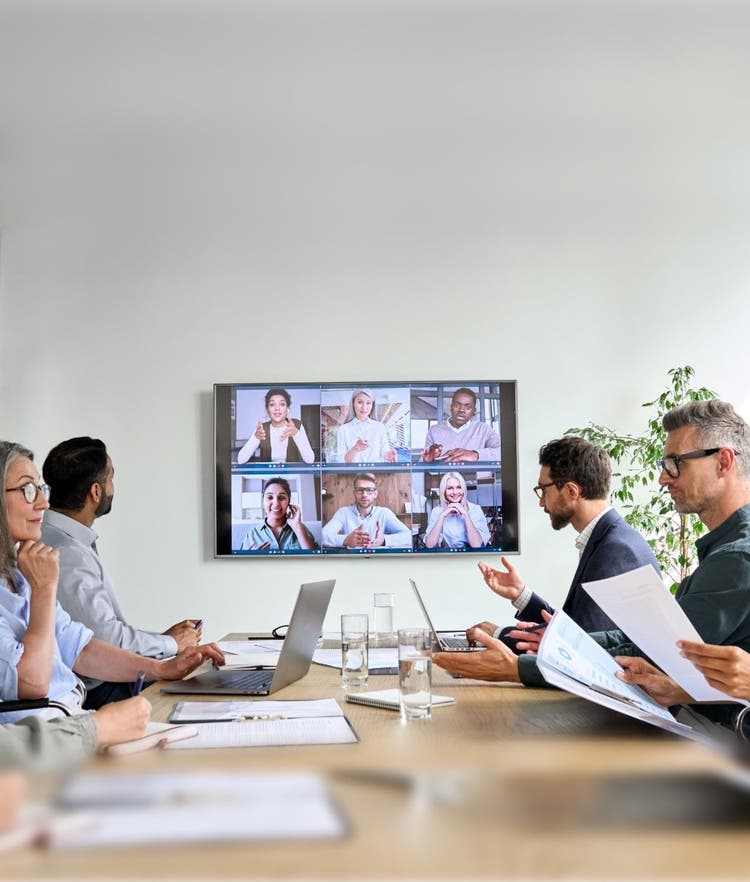
Insights
Innovation and collaboration in a hybrid world
Agnes Misiurny , Consulting Director – Innovation, UST
Instead of debating whether collaboration is easier in-person or online, organisations need to create better hybrid environments for both in-person and online employees to collaborate effectively.
Agnes Misiurny , Consulting Director – Innovation, UST

A seasoned design thinker with a global background in experience design, product management and startups. Agnes consults to organisations on sustainable innovation operating models. She also runs the UST Innovation Lab in Melbourne.
I don’t need to tell you that hybrid work is a thing, nor that it’s changing our very idea of the workplace. But that doesn’t mean all the challenges presented by a hybrid workplace are anywhere close to being solved. Most individuals, let alone organisations, are still very early in their journeys to discover what hybrid work looks like for them.
I always preach that innovation can only be achieved when people with diverse perspectives collaborate. Therefore, one aspect of this new world that challenges many organisations is how to achieve the same level of collaboration necessary for innovation and creativity to thrive.
In 2022, with lockdowns no longer happening, Apple CEO Tim Cook announced that employees would have to return to the office at least three days a week, arguing that in-person collaboration is essential to Apple’s innovation culture. This didn’t go down well with Apple’s employees, many of whom pushed back or even quit.
Recently, I chaired a panel as part of Melbourne Connect’s Innovation Week, entitled Innovation in a Hybrid World. A common theme throughout the session was the tension between old and new ways of working, as organisations seek a balance between physical and virtual collaboration. While we agreed that remote and flexible work have many positive attributes, debate continues about whether online collaboration can ever be an adequate replacement for working together in the same physical space.
Stephanie Wan, associate partner at architect firm ClarkeHopkinsClarke, related to Cook’s stance on in-person collaboration. “Within the architecture industry, you can collaborate digitally, obviously. But we find quite often that being physically together has a different energy. It can be more inspiring, and you might get better outcomes.”
However, some of the common arguments in favour of enforcing in-person collaboration might be a matter of perspective.
“We talk about generalisations like collaboration and teamwork and culture, but in the end, what does that all that mean?” said Colin McLeod, a professor in the Faculty of Business and Economics at the University of Melbourne and Executive Director of the Melbourne Entrepreneurial Centre. He argued that employers need to be very clear on the specific reasons why employees need to attend the office two or three days a week – and be open to honest conversations about which activities or tasks are best suited to which environment.
The changing role of the office
Prior to the pandemic, if I needed to run a workshop or a collaborative creative session, I would usually take the team off site, away from the workplace. It helps to foster a different mindset, creating a space where it’s easier to discuss and collaborate on new ideas without the surroundings continually bringing people’s thoughts back to their business-as-usual work.
But when a lot of that business-as-usual work – answering emails, writing reports, managing clients, entering data – can easily be carried out at home, our view of what the office is actually for changes dramatically.
“What we'll see is a reversal, where the workplace is where they come to collaborate, because it's no longer where they're doing their heads down work,” said Craig Stevens, APAC vice president of project delivery for InEight Inc., predicting this will accelerate the evolution of office design. “Our office has been designed with lots of places for people to hang out and chat and fewer places for heads down cubicle time.”
But even if collaboration is easier in a physical space, the option isn’t always available.
McLeod sees the global war for talent – particularly in digital fields such as software design – forcing organisations to hire more and more remote workers as they struggle to find the right skills within a reasonable commute of the office. As a result, some employees, partners and vendors may simply be located too far away to physically attend every (or any) meeting or brainstorming session.
The question is no longer whether innovation and collaboration are easier to achieve in-person or online. That boat sailed: The modern meeting is increasingly likely to be a hybrid meeting, if not completely remote.
Instead, organisations should be asking how to ensure both in-person and online spaces co-exist effectively in the same meeting.
Equalising the virtual and physical worlds
In hybrid meetings, with both virtual and physical attendees, the power dynamics usually favour those in the room. While this may be unintentional, the virtual screen becomes more of a window into the meeting rather than a seat at the same table.
An example of this inequality would be how meetings handle video and audio. A camera might stream video of the whole room to virtual attendees, but they would likely struggle to make out individual faces from the huddle of physical attendees around a table. Some people might be blocked from view entirely, becoming disembodied voices and leading to confusion about who is speaking. Further adding to the confusion, the audio can also vary wildly depending on how close people sit to the microphone.
These dynamics become even more complex when we consider any type of workshopping or co-creation activity. For example, remote attendees won’t be able to see a whiteboard or a wall of Post-its – let alone interact with them. Instead, they are reliant on those in the room to interact on their behalf, requiring more effort to convey thoughts or make otherwise simple changes. All of this can lead to increased misunderstandings, a greater reluctance to share ideas and reduced spontaneity.
A true hybrid meeting gives both the physical and virtual spaces equal consideration.
As architects, ClarkeHopkinsClarke understands the importance of spatial affordances – which is the functionality a space or place provides for specific activities – and that includes the role of physical environment in hybrid work. “You look at the experience you want to create first,” says Wan. “And then you think about the size of the group. What kind of interactions would your spatial setting provide for that size group? How long would they be interacting?
Wan believes organisations should think about the affordances of the digital world in a similar way. “It would give you cues to curate that experience so that it's as engaging as possible, applying the same set of rules so you’re able to give the same experience, whether digitally or physically.
One way to do this is for everyone in the room to also join the virtual meeting via their laptops. That way, physical attendees will have an equal presence in the virtual meeting.
And because everyone accesses the meeting with the same set of tools, viewing documents or sharing screens becomes a lot simpler. This also allows all attendees to collaborate on the same virtual whiteboard or other shared collaboration tools, such as Miro or Mural. Collaborative activities also become easier, encouraging more equal input.
The innovation of innovation
“What does it say to people when you say we're a team, we're all in this together, everyone's important – but you must come in three days a week,” said McLeod. “[It says] your culture is about top-down control. That's the message you're sending.” McLeod believes that organisations with traditional employment models will struggle to compete in the market until they start thinking about change – not only to workplace policies but also workplace environments and culture.
Stevens agrees that there’s still a long way to go. Team members who have spent years if not decades working and meeting in a particular way may still need some convincing to leave their comfort zones. “Our biggest challenge is getting customers to stop thinking about doing things the way they used to and instead embrace new paradigms,” he said. “We need to keep challenging people to open their minds to different ways of doing things. It's pretty early days.”
Innovation is always an incremental process – and innovating the ways in which we innovate in this new hybrid world will be no different.pro